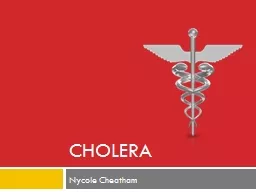

The Basics Infection Cause Cholera is an acute epidemic infectious disease caused by the bacterium Vibrio cholerae A soluble toxin elaborated in the intestinal tract by the bacterium activates the ID: 910662
Download Presentation The PPT/PDF document "Cholera Nycole Cheatham" is the property of its rightful owner. Permission is granted to download and print the materials on this web site for personal, non-commercial use only, and to display it on your personal computer provided you do not modify the materials and that you retain all copyright notices contained in the materials. By downloading content from our website, you accept the terms of this agreement.
Slide1
Cholera
Nycole
Cheatham
Slide2The Basics
Slide3Infection Cause Cholera is an acute epidemic infectious disease caused by the bacterium Vibrio cholerae. A soluble toxin elaborated in the intestinal tract by the bacterium activates the adenylate
cylase of the mucosa, causing active secretion of an isotonic fluid resulting in profuse watery diarrhea, extreme loss of fluid and electrolytes, and dehydration and collapse, but no gross morphologic change in the intestinal mucosa.
Slide4What parts of the world are affected?Cholera remains an ever-present risk in many countries. New outbreaks can occur sporadically in any part of the world where water supplies, sanitation, food safety, and hygiene are inadequate. The greatest risk occurs in overpopulated communities and refugee settings characterized by poor sanitation and unsafe drinking water.
Slide5Time FrameCholera was first discovered by Filippo Pacini in when the disease came to Florence in 1854 during the Asiatic Cholera Pandemic of 1846-63. Since then Cholera has had several outbreaks in developing countries because of the lack of a fresh water supply.
Slide6The Symptoms
Slide7How Do
You G
et
I
t?
A person can get cholera by drinking water or eating food contaminated with the cholera bacterium. In an epidemic, the source of the contamination is usually the feces of an infected person that contaminates water and/or food. The disease can spread rapidly in areas with inadequate treatment of sewage and drinking water. The disease is not likely to spread directly from one person to another; therefore, casual contact with an infected person is not a risk for becoming ill.
Slide8What Does Cholera Affect?Cholera is an infection in the
intestines. The body is affected because it becomes dehydrated due to vomiting and diarrhea. A person with cholera must always be hydrated, preferably with drinks containing electrolytes.
Slide9Symptoms?Cholera infection is often mild or without symptoms, but can sometimes be severe. Approximately one in 20 (5%) infected persons will have severe disease characterized by profuse watery diarrhea, vomiting, and leg cramps. In these people, rapid loss of body fluids leads to dehydration and shock. Without treatment, death can occur within hours.
Slide10How Long Until Death Occurs?
A person with Cholera can be simply and successfully treated by immediate replacement of the fluid and salts lost through diarrhea.
Without vaccination a person who has contracted the Cholera disease can die within 3-4 hours.
Developed
Undeveloped
Slide11How Does It Spread?The disease is not likely to spread directly from one person to another; therefore, casual contact with an infected person is not a risk for becoming ill
. To contract the disease you must have also drank some of the water with the bacteria in it.
Slide12How Many People Die Annually?
Cholera is very rare in industrialized nations and when it is present, the disease is usually treated and the people live.
Approximately 200,000 cases are reported to the World Health Organization every year. However, the WHO believes the true number of cases annually is between 3-5 million, with 100,000 to 120,000 deaths.
Developed
Undeveloped
Slide13Possibility of Recovery?Cholera can be treated with antibiotics but it is not necessary for the person to heal completely. By rehydrating the body and putting salts back in the body lost from diarrhea, a person can survive this disease.
Slide14Treatment
Slide15Basic Traditional Treatments
The most simple treatment for cholera is to drink a mixture of water and salts to rehydrate the body.
Slide16Modern Medicine Treatment
Antibiotics shorten the course and diminish the severity of the illness, but they are not as important as receiving rehydration. Persons who develop severe diarrhea and vomiting in countries where cholera occurs should seek medical attention promptly
.
Slide17Cure
Who :
Filippo
Pacini
(1812-83) was born in Pistoia, Italy on May 25, 1812
.
What
: Discovered a comma-shaped bacillus which he described as a Vibrio. He published a paper in 1854 entitled, "
Microscopical
observations and pathological deductions on cholera" in which he described the organism and its relation to the disease
.
When
: Cholera
came to Florence in 1854 during the Asiatic Cholera Pandemic of
1846-63
Although
Pacini
discovered Cholera in 1854, he wasn’t recognized for it until many years later.
Slide18Research & Treatment OrganizatonsU.S. and international public health authorities are working to enhance surveillance for cholera, investigate cholera outbreaks, and design and implement preventive measures across the globe. The Centers for Disease Control and Prevention (CDC) investigates epidemic cholera wherever it occurs at the invitation of the affected country and trains laboratory workers in proper techniques for identification of Vibrio
cholerae.
In underdeveloped countries, there aren’t really any organizations that help with funding cholera research and treatment.
Developed
Undeveloped
Slide19Cost of Treatment
The most basic of cholera treatments cost about 20 cents. In developing countries, that might not be the best solution considering they may not be able to afford it. A quick mix of salt and water can be made cheaply and for a low cost.
Slide20ReferencesEncyclopedia of Earth- Cholera. (2008, 02 28). Retrieved from http://www.eoearth.org/view/article/151109
/World Health Organization- Cholera. (2012, 07). Retrieved from http://www.who.int/mediacentre/factsheets/fs107/en
/
Medical News Today- What is cholera? what causes cholera. (2010, 05 19). Retrieved from
http://
www.medicalnewstoday.com/articles/189269.php
Centers for Disease Control and
Prevention- Cholera - vibrio
cholerae
infection. (2013, 07 30). Retrieved from
http://www.cdc.gov/cholera/general
/
Who first discovered vibrio
cholerae
. (
n.d.
). Retrieved from
http://
www.ph.ucla.edu/epi/snow/firstdiscoveredcholera.html